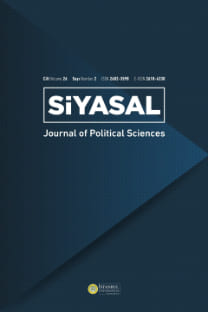ORTADOĞU'DA DİKTATÖRLÜK SONRASI SEÇİM SİSTEMİ TASARIMI MISIR VE IRAK
Bu makalede Ortadoğu'da diktatörlük rejimi sonrası geçiş döneminde seçim sistemi tasarımı bağlamında Irak ve Mısır incelenmektedir. Bu ülkelerde rejim değişikliğini serbest ve adil seçimler izlemiştir. Ancak her iki ülke de 2014 sonu itibarıyla büyük bir belirsizlik içinde bulunmaktadır. Irak'ta seçim sistemi, orantısallığı yüksek oranda gözeten bir şekilde tasarlanmıştır. Bu, ülkedeki farklı mezhepsel ve etnik kimliklerin parlamentoda adil biçimde temsilini sağlamış, ancak bir yandan da siyasal gruplaşmaların etnik/mezhepsel kimliklerin izdüşümü olmasına yol açmıştır. Mısır'da ise nispi temsilin uygulandığı çevrelerden orantısal bir sandalye dağılımı çıkmış, ancak dar bölgelerde İslamcılar oy oranlarından daha yüksek oranda sandalye kazanmıştır. Bu da parlamentoda net bir üstünlük sağlamalarına katkıda bulunmuştur.
POST-DICTATORSHIP ELECTORAL SYSTEM DESIGN IN THE MIDDLE EAST: THE CASES OF EGYPT AND IRAQ
This article analyses Egypt and Iraq in the context of the electoral system design during the postdictatorial transition process. Regime changes in both countries were followed by free and fair elections. However, as of late 2014 both countries are in a heavy state of uncertainty. The Iraqi electoral system was designed so as to materialize a high level of proportionality. On the one hand, this made the fair representation of different ethnic, religious and sectarian groups in the parliament possible. On the other,it made political groupings nothing but the reflection of the ethnic and sectarian identities. In the districts where the PR applied in Egypt the seat distribution proved to be proportional, however in the single member districts the Islamists won a much larger proportion of seats than their vote share. This contributed to their dominance in the parliament.
___
- o Al-Sheikh, SafaRasulve Sky, Emma (2011) 'Iraq since 2003: Perspectives on a Divided Society', Survival, 53 (4).
- o Antar, Noha (2006) 'The Muslim Brotherhood's Success in the Legislative Elections in Egypt 2005: Reasons and Implications' Euromesco Paper, 51.
- o BBC, 'Egypt: Who holds the power?', http://www.bbc.co.uk/news/world-middleeast-18779934 (son erişim tarihi: 18/07/2015).
- o Blaydes, Lisa (2011) Elections and Distributive Politics in Mubarak's Egypt, New York: Cambridge University Press.
- o Braam, Ernesto H. (2010) 'All Roads Lead to Najaf: Grand Ayatollah Al-Sistani's Quiet Impact on Iraq's 2010 Ballot and Its Aftermath', Journal of International and Global Studies, 2 (1).
- o Byman, Daniel (2012) 'Regime Change in the Middle East: Problems and Prospects', Political Science Quarterly, 127 (1).
- o Colomer, Josep M. (ed.) (2004) Handbook of Electoral System Choice, Hampshire ve New York: Palgrave Macmillan.
- o ______ (2004) 'The Strategy and History of Electoral System Choice', Handbook of Electoral System Choice, Josep M. Colomer (ed.) içinde, Hampshire ve New York: Palgrave Macmillan.
- o ______ (1995) 'Strategies and Outcomes in Eastern Europe', Journal of Democracy, 6 (2).
- o 'Election Law for the 2010 Council of Representatives Elections', http://www. orsam.org.tr/tr/trUploads/Secimler/1/Dosyalar/2010223_Election%20Law%20for%20
- the%202010%20Council%20of%20Representatives%20Elections.pdf (son erişim tarihi: 15/07/2015).
- o 'Elections in Egypt: The Electoral Framework in Egypt's Continuing Transition: February 2011 - September 2013', IFES Briefing Paper, October 2013, http://www. ifes.org/sites/default/files/egypt_briefing_paper_sept_2013_final.pdf (son erişim tarihi: 31/07/2015).
- o Farris, David M. (2012) 'Constituting Institutions: The Electoral System in Egypt', Middle East Policy, 19 (1).
- o Freedom House, 'Freedom in the World: Country Ratings', https://freedomhouse. org/report-types/freedom-world#.VHK-aMnpz8Q (son erişim tarihi: 24/11/2014).
- o Ghanem, As'adve Mustafa, Mohanad (2011) 'Strategies of electoral participation by Islamic movements: the Muslim Brotherhood and parliamentary elections in Egypt and Jordan', Contemporary Politics, 17 (4).
- o Gürseler, Ceren (2010) 'Will Elections Bring Change to Egypt?', Ortadoğu Analiz, 2 (19-20).
- o Tadros, Samuel (2012) 'Egypt's Elections: Why the Islamists Won', World Affairs, 2.
- o Hassan, Mazen (2012) 'Elections of the People's Assembly, Egypt 2011/12', Electoral Studies, 32.
- o Hayden, Jacqueline (2006) The Collapse of Communist Power in Poland: Strategic misperceptions and unanticipated outcomes, Oxon ve New York: Routledge. o Lijphart, Arend (1994) Electoral Systems and Party Systems: A Study of TwentySeven Democracies, 1945-1990, New York: Oxford University Press.
- o _____ (1999) Patterns of Democracy, New Haven: Yale University Press. o McLaren, Lauren M. (2008) Constructing Democracy in Southern Europe: A comparative analysis of Italy, Spain, and Turkey, Oxon: Routledge.
- o O'Donnell, Guillermo; Schmitter, Philippe C.; Whitehead, Laurence (eds.) (1986)
- Transitions from Authoritarian Rule: Southern Europe, Baltimore ve Londra: The Johns Hopkins University Press.
- o Shehata, Dina (2007) Islamists and Secularists in Egypt: Opposition, Conflict, andCooperation, London: Routledge.
- o Shugart, Matthew Sobergve Wattenberg, Martin P. (eds.) (2001) Mixed-Member Electoral Systems: The Best of Both Worlds?, New York: Oxford University Press.
- o Shvetsova, Olga (1999) 'A survey of post-communist electoral institutions: 1990- 1998', Electoral Studies, 18.
- o Thabet G. Hala (2006) 'Egyptian Parliamentary Elections: Between Democratisation and Autocracy', Africa Development, XXXI (3).
- o Van der Eijk, Cees; Franklin, Mark N. Franklin (2009)Elections and Voters, Basingstoke: Palgrave Macmillan.
- o Visser, Reidar (2014) 'Iraq: Democracy and Electoral Politics in Post-Saddam Era', Elections and Democratization in the Middle East: The Tenacious Search for Freedom, Justice, and Dignity, M. Hamadve K. Al-Anani (ed.) içinde, New York: Palgrave Macmillan.
- o Yamao, Dai (2012) 'Sectarianism twisted: Changing cleavages in the elections of post-war Iraq', Arab Studies Quarterly, 34 (1).
- ISSN: 1303-1260
- Yayın Aralığı: 2
- Yayıncı: İstanbul Üniversitesi
